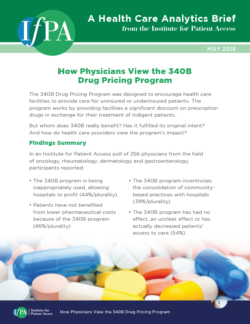New research suggests that President Donald Trump, U.S. senators and the country’s physicians may agree on at least one thing: the federal 340B drug pricing program deserves more scrutiny. Designed to encourage care for indigent and underinsured patients, the program has ballooned into a revenue stream for growing hospital systems.
 In the president’s newly released “Blueprint to Lower Drug Prices,” he notes that “Some hospitals that receive drug discounts under the 340B program… do not provide meaningful levels of charity care to low-income and vulnerable patients, ultimately pushing up drug prices for patients with private health insurance.”
In the president’s newly released “Blueprint to Lower Drug Prices,” he notes that “Some hospitals that receive drug discounts under the 340B program… do not provide meaningful levels of charity care to low-income and vulnerable patients, ultimately pushing up drug prices for patients with private health insurance.”
Meanwhile, the Senate Health, Education, Labor and Pensions Committee convened Tuesday to examine oversight reports on the 340B program. The hearing is the second on the issue in just two months. At a March 15 hearing, Committee Chairman Lamar Alexander (R-Tenn.) remarked upon “confusion” surrounding the program’s goals. Senator Alexander noted that 1.3 percent of all prescription drug spending in the United States goes to 340B institutions.
And policymakers aren’t the only ones with concerns. Physicians also have qualms about the program.
Released in advance of Tuesday’s Senate hearing, new research from the Institute for Patient Access captures the opinions of 256 rheumatologists, dermatologists, oncologists and gastroenterologists. Physicians reported that:
- The 340B program is being inappropriately used, allowing hospitals to profit. (44%/plurality)
- Patients have not benefitted from lower pharmaceutical costs because of the 340B program. (46%/plurality)
- The 340B program incentivizes the consolidation of community-based practices with hospitals. (39%/plurality.)
- The 340B program has had no effect, an unclear effect or has actually decreased patients’ access to care. (54%)
The 340B program provides qualifying facilities a significant discount on prescription drugs in exchange for their treatment of indigent patients. In addition to savings from front-end discounts, 340B facilities also generate revenue when the reimbursement they receive for a drug exceeds the discounted price they paid for it. This occurs when hospitals receive more than the discounted purchase price for drugs administered to patients who have Medicare or commercial health care coverage.
The system saved facilities $6 billion in 2015 alone, IfPA’s report notes. It’s little surprise, then, that the number of facilities covered by 340B is growing. Participation jumped from 583 in 2005 to 2,140 in less than a decade’s time. By 2014, more than 40 percent of the nation’s hospitals were participating, even though roughly two-thirds of them spent less on charity care than the national average.
Ideally, participating facilities would pass the savings along to the patients, or apply the revenue to uncompensated charity care. But there are no federal rules about how hospitals can use the funds. As one polled rheumatologist noted, “The program is saving hospitals and covered entities money, but they are not passing it onto patients through lower costs just increasing profits.”
Meanwhile, the ability for satellite offices to reap the same 340B benefit as their parent hospital is driving hospital systems to consolidate community-based practices. The move could leave patients with fewer options and less access to their physicians’ offices.
To learn more, read IfPA’s Health Analytics Brief, “How Physicians View the 340B Drug Pricing Program.”

